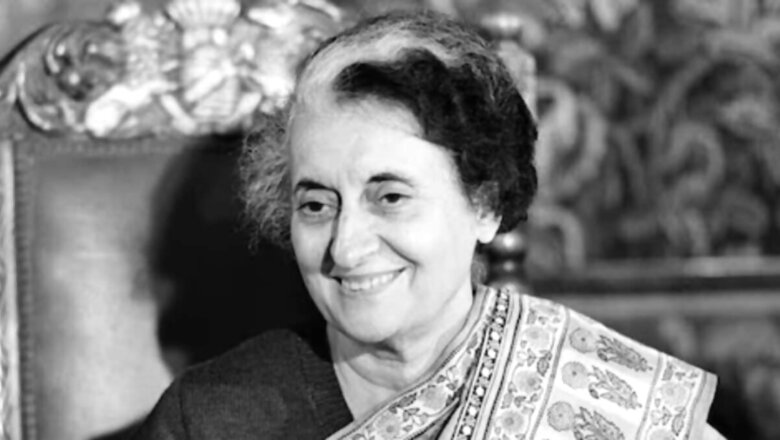
views
Indira Gandhi could barely wait to get even with the Supreme Court for circumscribing parliamentary supremacy. As Chief Justice S.M. Sikri retired on April 25, 1973 — only a day after delivering the judgment in Kesavananda Bharati v State of Kerala — Justice Ajit Nath Ray was appointed as his successor by superseding three judges viz. Justice J.M. Shelat, Justice K.S. Hegde and Justice A.N. Grover, compelling them to resign in protest.
Since there was no collegium system then, the government could easily overpass the seniority rule in the judiciary. Justice A.N. Ray had delivered a dissenting opinion in Kesavananda Bharati, favouring the government’s position on unlimited amending power.
Two years later, the Emergency was declared on June 25, 1975. Indira Gandhi chose to dispense with the parliamentary convention and constitutional mandate (Article 74) that the Council of Ministers should aid and advise the President. The formal cabinet approval for the declaration of Emergency was secured posterior to the President of India signing the notification. Kuldip Nayar informs that the cabinet meeting was scheduled at 6 AM on June 26, 1976 (The Judgement, P.41). President Fakhruddin Ali Ahmed had signed the proclamation of Emergency the previous night at 11.45 PM, marking the beginning of the Emergency and arrest of the Opposition members, social activists, and journalists etc.
The fact that cabinet approval for the Emergency followed, and not preceded, the President of India’s proclamation of Emergency under Article 352 actually became the ground for a Constitution amendment later on. After the Janata Party government was formed in 1977, it brought 43rd and 44th amendments to the Constitution mainly to nullify various detrimental aspects of the Constitution (42nd Amendment Act), 1976 enacted by the Indira Gandhi government during the Emergency.
The Constitution (44th Amendment) Act, 1978 extensively revised Article 352. It replaced the expression “internal disturbance”, which lent itself to a wide variety of (mis)interpretations, with “armed rebellion” though the President might not wait for the actual outbreak but act if there was imminent danger. The Constitution (44th Amendment) Act, 1978 virtually made the proclamation of Emergency for political agitation impossible. Indira Gandhi (thanks to the legal brain of West Bengal Chief Minister Siddhartha Shankar Ray, Bar at Law) had capitalised upon the expression “internal disturbance” as a possible ground for Emergency to thwart Jaya Prakash’s Narayan’s agitation. On that fateful night of June 25, 1975, it was Ray and not any member of the Union cabinet who had accompanied Indira Gandhi to Rashtrapati Bhawan and explained the legal position to President Fakhruddin Ali Ahmed.
Indira Gandhi sought to defend her position rather than the nation through the Emergency. The Emergency was proclaimed within a fortnight to the adverse judgment of Allahabad High Court dated June 12, 1975, that held her guilty of electoral malpractice in the Fifth Lok Sabha election. Instead of resigning from office, she responded by proclamation of Emergency. Unable to rely completely on her appeal in the Supreme Court against the Allahabad High Court verdict, Indira Gandhi took things in her own hands. In the process, she reduced the Constitution to a plaything. Before the Supreme Court would decide on her appeal, the Constitution (39th Amendment) Act, 1975 was enacted on August 10, 1975, to place inquiry into any dispute regarding elections of the president, vice president, Lok Sabha speaker and prime minister in the hands of a special forum rather than the judiciary.
The serious lacuna in this approach was that whereas elections to the august offices of the president (vide Articles 54 and 55) and vice president (vide Article 66) are specifically defined in the Constitution, there are no separate elections to the offices of Lok Sabha speaker and prime minister who are elected as ordinary Members of Parliament under the provisions of Representation of the People Acts, 1951. The Constitution under Article 71 authorises the Supreme Court to inquire and decide any dispute related to elections to the offices of the president and vice president.
The power to decide petitions related to elections of parliament and State legislatures was originally given to the Election Commission of India under Article 324 (1) through the setting up of election tribunals. However, the Election Commission itself decided to forgo the same after the third General Elections, 1962 which prompted the government to promulgate the Constitution (19th Amendment) Act, 1966 whereby the high court was authorised to adjudicate election petitions.
The Supreme Court, by a 5-3 vote, nullified this amendment on November 7, 1975, while hearing Indira Gandhi’s appeal to the June 12 judgment of the Allahabad High Court. However, it unanimously reversed her conviction on June 12 on two electoral offences. The verdict, says Kuldip Nayar, was not based on fact but rather on an election law amendment adopted by Parliament in August (The Judgement, P.93).
Barely had the ink dried on the parchment, when another mischief was set into motion. The Supreme Court had relied heavily on the “basic structure doctrine” in delivering its November 7, 1975 judgment. On November 10, 1975, a bench of 13 judges of the Supreme Court assembled to hear the plea of the Government of India that the decision in the Kesavananda Bharati case should be overruled. Eminent jurist Nani A. Palkhivala filed a suit in opposition to that plea. Due to censorship, the news was not published in any newspaper.
Palkhivala argued that the Keshavananda Bharati case was heard by the largest bench constituted prior to the November 10, 1975 assemblage. It took the longest time for a case in the Supreme Court i.e. five months, and the vastest material ever brought together in a single case formed the record. No justification existed for reconsidering a ruling arrived at after the fullest and most detailed consideration. Setting up a full bench to review the previous judgment of a full bench would set a wrong precedent. The process could become unending and damage the judicial propriety. Further, time was most ill-opportune to undertake such a review, when there was no effective Opposition inside the Parliament, no freedom to write or speak anything in disagreement to the government, and there was a suspension of Fundamental Rights and liberty.
After arguments extending over two days, informs Palkhivala, “The Bench was dissolved, and the attempt to confer on Parliament an unlimited power amending the Constitution happily failed” (We, the People, P.183).
Unable to regain unlimited constituent power through the legal route, and dissatisfied with the tardiness of the Parliamentary system, Indira Gandhi even contemplated adopting a Presidential form of government for India. The French system appealed most to her. Sanjay Gandhi, who gained great prominence and notoriety during the Emergency, openly pitched for a Presidential system that gave one person all the power, without curb from Parliament (The Judgement, P.114). The Swaran Singh Committee set up by the Congress in February 1976 came out with proposals for extensive changes in the Constitution. “It would have been worse if I were not there,” Swaran Singh later told Kuldip Nayar, “we buried the Presidential system once and for all” (The Judgement, 148).
The mindset of the government was evident in a 23-page paper produced by the research and reference division of the Ministry of Information and Broadcasting released on March 4, 1976. It was titled ‘Limitations on Fundamental Rights: Some Notes on the Views of the Founding Fathers’. A selective reading of the views of the members of the Constituent Assembly, it overlooked the fact that the Constitution, as originally adopted, represented the collective wisdom of the Constituent Assembly.
The Swaran Singh Committee’s proposals became the substance of the Constitution (44th Amendment) Bill, 1975 comprising 55 clauses affecting a number of articles in the Constitution. A great indignation was created in the intelligentsia; and nearly 300 educationists, artists and writers wrote to Indira Gandhi against proceeding with those amendments. However, such counsels were in vain, for the iron lady who had decided to be Empress of India. The Bill was passed with a heavy majority, in a Lok Sabha shorn of Opposition leaders, who languished in jails. This became the Constitution (42nd Amendment) Act, 1976 after ratification by the requisite number of States. The 42nd Amendment is often dubbed as a “mini Constitution” for having almost revised the Constitution along with the Preamble.
Nani A Palkhivala describes the legislation as a “devastating attack on the Constitution”, more so because it was undertaken under the guise of the Emergency. When the Janata Party came to power, they enacted the Constitution (44th Amendment) Act, 1978 which was aimed at reversing several controversial provisions of the 42nd Amendment.
They also deleted “Article 31: Compulsory acquisition of property” – which has been at the heart of most number of judicial conflicts over the Constitution – from the Chapter on Fundamental Rights and moved it to another part of the Constitution, Part XII, thus making it only a legal right. The departure of the Right to Property under Part III (Fundamental Rights) spared the rest of the Fundamental Rights from the attack of the State.
The remaining work was done by the judiciary in its verdict in Minerva Mills Ltd & Ors v Union of India & Ors (1980), which ruled that parliament’s power to amend the Constitution was not absolute and therefore amendments in Articles 31C and 368 done under 42nd amendment were invalid. This brought curtains down the great Constitutional struggle, which Rahul Gandhi wants to conveniently forget.
This is the concluding instalment of two-part series.
(The writer is author of the book ‘The Microphone Men: How Orators Created a Modern India’ (2019) and an independent researcher based in New Delhi. Views expressed in the above piece are personal and solely those of the author. They do not necessarily reflect News18’s views)



















Comments
0 comment